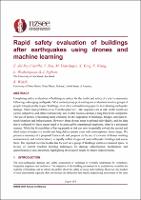Rapid, automated, post-earthquake building assessment using a swarm of drones and machine learning techniques

Download
Date
2021-04-14Authors
del Rey Castillo, Enrique
Zhou, Yang
Liarokapis, Minas
Yang, Xiaofei
Wang, Feng
Walsh, Kevin
Wotherspoon, Liam
Ingham, Jason
Metadata
Show full item recordAbstract
Completing safety evaluations of buildings is critical for the health and safety of a city’s community following a damaging earthquake. Most contemporary post-earthquake evaluations involve groups of people who physically inspect buildings, most often without training specific to evaluating earthquake damage. Three main problems arise from this practice: i) the inspectors are at risk, ii) the results are varied, subjective, and often contradictory, and iii) the process can take a long time to be completed. The use of drones is becoming more common for the inspection of buildings, bridges, and hard-to-reach locations and infrastructure. However, these drones must be piloted individually, and the data that is collected by these means need to be assessed by experienced engineers, often in a piecemeal manner. While the first problem of having people at risk can now be partially solved, the second and third issues of subjective results and long delays remain even with contemporary drone usage. We present a summary of a proposed framework and progress on the use of a swarm of drones working autonomously and collaboratively to rapidly collect images of post-earthquake buildings and assess them. The reported exercise to date has focused on a group of buildings within a contained space. A review of current machine learning techniques for damage identification, localization, and quantification is also presented, highlighting the research needs for future improvements.
